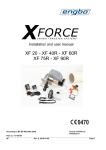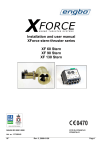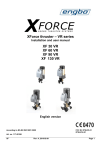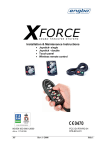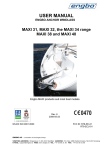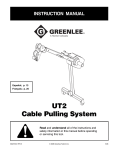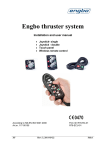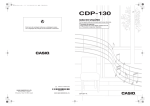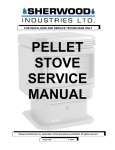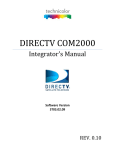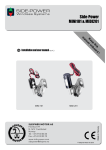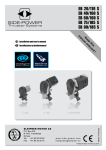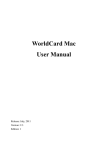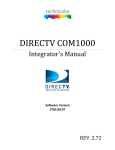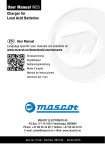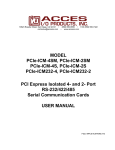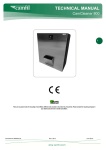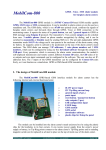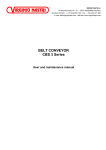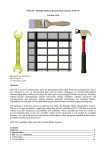Download Tunnel mounting
Transcript
XForce stern-thruster series Installation and user manual XF60SR XF90SR XF130SR English version According to NS-EN ISO 9001:2000 FCC ID: R78-RC-01 R78-ECU-01 Art. no. 117-00165 XF Rev: 4, 2010-02-01 Page 1 Contents 1. INTRODUCTION .............................................................................................................. 3 2. OPERATION ..................................................................................................................... 4 2.1. 2.2. XForce intelligent protection control ............................................................................................................. 4 How to operate the thruster .......................................................................................................................... 4 2.2.1. 2.2.2. 2.2.3. 2.2.4. 2.2.5. 2.2.6. Operating panel versions ...................................................................................................................................... 4 Operating instructions........................................................................................................................................... 5 Directions for use.................................................................................................................................................. 5 RCU – Remote Control Unit ................................................................................................................................. 6 Coding of wireless remote control ........................................................................................................................ 6 Battery replacement ............................................................................................................................................. 7 3. TECHNICAL SPECIFICATIONS WIRELESS REMOTE CONTROL ................................ 8 4. DIMENSIONS ................................................................................................................... 8 4.1. 4.2. 4.3. Dimensions XF60SR, XF90SR and XF130SR............................................................................................. 8 Dimensions RCU – Remote Control Unit ..................................................................................................... 9 Installation of RCU – Remote Control Unit................................................................................................... 9 5. INSTALLATION OF THE THRUSTER ............................................................................. 9 5.1. 5.2. 5.3. Avoid water damage..................................................................................................................................... 9 Compartment area ..................................................................................................................................... 10 Determine the location for the stern thruster .............................................................................................. 10 6. MECHANICAL INSTALLATION ..................................................................................... 11 6.1. 6.2. Exploded view (XF90SR) ........................................................................................................................... 11 Propeller installation ................................................................................................................................... 12 7. ELECTRICAL CONNECTIONS ...................................................................................... 13 7.1. 7.2. 7.3. 7.4. 7.5. 7.6. 7.7. 7.8. 7.9. 7.10. 7.11. 7.12. Installation of the touch panel .................................................................................................................... 13 Joystick installation ..................................................................................................................................... 14 Connecting the RCU control cable ............................................................................................................. 14 Contradicting direction ................................................................................................................................ 15 Connecting cables to the bow thruster ....................................................................................................... 15 Connecting cables to the battery ................................................................................................................ 16 Fuse connections ....................................................................................................................................... 16 Recommended main switch ....................................................................................................................... 16 Main switch terminal ................................................................................................................................... 16 XForce Thruster Cable, fuse and battery requirements ......................................................................... 17 Wiring diagram ........................................................................................................................................ 17 Wiring diagram single and double joystick ............................................................................................. 18 8. MAINTENANCE ............................................................................................................. 19 8.1. 8.2. 8.3. 8.4. 8.5. Mechanical check ....................................................................................................................................... 19 Corrosion check ......................................................................................................................................... 19 Battery/charger check ................................................................................................................................ 19 High current cable/connections check ....................................................................................................... 19 Joystick/operator panel check .................................................................................................................... 20 9. TROUBLESHOOTING.................................................................................................... 20 9.1. The thruster does not work......................................................................................................................... 20 9.2. The thruster does not work or has an unexpectedly low performance ...................................................... 20 9.3. The thruster works in only one direction .................................................................................................... 21 9.4. The thruster runs in contradicting direction ................................................................................................ 21 The thruster runs for short intervals or a clicking sound is to be heard from the thruster ..................................... 22 9.5. The thruster stops working after a long period of use ................................................................................ 22 10. INSTALLATION OF EQUIPMENT WITH HIGH CURRENTS. ........................................ 22 10.1. Special considerations. ........................................................................................................................... 22 10.1.1. 10.2. XF Preface/introduction............................................................................................................................................ 22 Battery..................................................................................................................................................... 23 Rev: 4, 2010-02-01 Page 2 10.2.1. 10.2.2. 10.2.3. 10.2.4. Battery-cables/lugs ............................................................................................................................................. 23 Battery connection .............................................................................................................................................. 23 Fuse connection ................................................................................................................................................. 24 Main switch connection ...................................................................................................................................... 24 1. Introduction First of all, we would like to thank you for choosing the XForce Thruster. Engbo AS has for several years supplied Volvo Penta with thrusters, distributed as QL thrusters through Volvo Penta dealers and distributors. In late 2006, Engbo and Volvo Penta agreed that distributing through two channels and brand names would make our thrusters even more available. Together with Engbo anchoring and mooring systems, the thrusters constitute a complete system for manoeuvring and mooring your vessel. The control units for both thrusters and winches are based on the same modules, which makes it possible to manoeuvre and anchor using one single wireless remote control. To achieve maximum benefit from your XForce thruster, please study this manual thoroughly before installing and making use of the thruster panels. Keep this manual onboard. Do not hesitate to contact us if you have any questions. Best regards, Engbo AS P.O. Box 2288 Postterminalen N-3103 Tønsberg Norway E-mail: [email protected] Web: www.engbo.no IMPORTANT: Please read the entire instruction carefully before starting on the installation work. The installation instructions are only produced for professional use of qualified personnel and are not intended for non-professional use. Engbo will not assume any liability whatsoever for damage incurred, either damage to materials or personal injury, which may result if the installation instructions are not followed or if the work is carried out by non-professional personnel. The manufacturer does not assume any liability for the installation of the thruster panels. Qualified installers should be familiar with these installation instructions. The responsibility for the installation rests entirely on the installer. Suitable protective equipment must be used during installation. Compliance with regulations must be ensured by the installer. Faulty installation or connection of any components will render any warranty given by Engbo AS void. IMPORTANT: When installed in boats approved or classified according to international or special national rules, the installer is responsible for following the demands in accordance with these regulations / classification rules. The instructions in this manual cannot be guaranteed to comply with all different regulations / classification rules. The remote control is approved for use in EU/EFTA countries (CE) or US/Canada (FCC). For other countries, please contact your local authorities. XF Rev: 4, 2010-02-01 Page 3 2. Operation IMPORTANT: XForce thruster(s) must only be operated by persons with knowledge of the system. Keep main engine(s) running when operating thruster(s) to ensure enough electrical power. Only operate the thruster(s) with the propellers fully submerged. Test running WARNING: Do not operate the thruster(s) without the belt cover installed. Make sure no one is within reach of the rotating propeller(s) The propeller(s) must come to a stop before running in opposite direction, otherwise the contactors will burn / fuse. NB: When the boat is launched check that it moves in the correct directions when operating the control panel. If not, shift the cables connected to no. 1 and no. 3 on the control unit, or when it concerns MCU with integrated radio receiver, change position on DIL switch 8 on S100 (see 10.4). 2.1. XForce intelligent protection control Intelligent electronic protection control Automatic intelligent monitoring will shut off the thruster if too low voltage. The system has intelligent monitoring to measure run and pause time. The XForce Thruster is not permitted to start if the voltage on the thruster is below 10.0V on 12V system/ 20.0V on 24V system. If the voltage at the thruster drops below 9.0/18.0V when thruster is running, warning will occur by showing orange power light on the wireless control. Electronic protection system prevents the thruster from continue to run in case of solenoid lockin. (Solenoid versions.) Automatic intelligent monitoring measures run and pause time to protect the motor and control unit against overheating. Max continuous running time: 4 intervals of 30 sec – S2 = 2 min. Of security reasons, the system permits continuous running of the thruster in 4 intervals of 30 sec. After each interval, the thruster will stop. Switching off / on the joystick or switch panel will make the thruster run again. If repeated 4 times, (total 2 minutes running), the thruster will need to cool down for 25 minutes before being ready to run again. This to protect the motor and control unit against overheating. NB: In an emergency situation, to save the ship from any damage, this protection can be override by turning the main switch off and on. Time delay when changing direction protects against mechanical and electric overload. Shear pin between thruster motor and drive shaft protects mechanical parts if the propeller is obstructed from rotation. 2.2. How to operate the thruster Move the joystick / press the touch panel to right and the thruster will be activated to starboard. Move the joystick / press the touch panel to left and the thruster will be activated to port. 2.2.1. Operating panel versions There are 4 different XForce Thruster operation panels available. Touch panel (Part no.12-79001) Easy to install. Designed similar to Engbo winch panel. XF Rev: 4, 2010-02-01 Page 4 Single Joystick (Part no.12-79002) ON/OFF switch, LEDs for indication of power and direction. Double joystick (Part no.12-79003) Needed if both bow and stern thruster installed. ON/OFF switch. LEDs for indication of power and direction. Wireless remote control (Part no.12-47014) Splash-proof, remote control unit. The wireless remote control can be used to operate maximum two thrusters and two windlasses, bow and stern. Activates both bow and stern thruster simultaneously in opposite direction by pushing the centre buttons. Operation range of +30 m under normal conditions. High quality, narrow band unit with two-way communication with the electronic control unit. Each electronic control unit has a unique code. Equipped with anti-slip strips on the backside. Holder and hand/neck cord is included as standard (easily removed). The battery lifetime is more than 2 seasons based on normal leisure use. IMPORTANT! Always install at least one fixed XF Thruster panel. 2.2.2. Operating instructions The remote control is battery-operated. To ensure longer life, it will automatically go into sleep mode five minutes after the last button was pushed. Deactivation is signalled with two short sound bursts and a blinking “POWER” indicator. The remote control is activated by holding down any button for 1.5 seconds. When the remote control has been activated, the selected thruster can immediately be operated by pressing the “arrow” button in the desired direction. The thruster will be running as long as the button is pressed down. (Max 4x30 sec.) 2.2.3. Directions for use Push the left arrow button, and the thruster moves the boat to port. Push the right arrow button, and the thruster pushes the boat to starboard. Pushing the centre (twin arrow) buttons on the wireless remote activates both bow and stern thruster simultaneously in opposite directions. The boat will start to rotate about the vertical axis. (Requires both bow and stern thrusters installed.) Green light NB: Activation is indicated by a steady green light in the “POWER” indicator and a short sound. All subsequent use of buttons is shown on the associated indicator above the button, accompanied by a short sound. Green light indicates everything normal and ready. XF Rev: 4, 2010-02-01 Page 5 Orange light Orange light indicates warning conditions, e.g low voltage at the electronic unit. Red light The indicator will quickly blink red in case of system faults and slowly blink red together with short sounds if the remote is unable to communicate with the electronic unit. If the thruster is overloaded and requires time to cool down, this will also be indicated by quick red flashing. These error indications are shown when buttons are pushed. 2.2.4. RCU – Remote Control Unit XF40R, XF60R, XF75R and XF90R are supplied with the power contactor fixed to the thruster motor and separate electronic Remote Control Unit (RCU) with integrated receiver for the wireless remote enclosed. The antenna is preinstalled inside the electronic thruster control. IMPORTANT! Turn off the thruster main switch when not in use. The radio receiver current consumption will be approx 3.5 W as long as it is turned on. 2.2.5. Coding of wireless remote control Procedure for serial no. above 8600 Important! If your wireless control has serial no. lower than 8600, use the procedure enclosed your remote. 1. How to put the wireless control unit in code mode: Select the pair of switches on the remote control to be coded. Press down both switches simultaneously for approximately 12 seconds. When you hear a short sound signal and the green power light starts to flash, the remote control is prepared for coding and will stay in coding mode for 5 minutes or until the coding has been finished. (Image A) Image A Image B XF 2. How to put the receiver unit in code mode: Alt. 1. Touch panel installed. Press and keep both switches on the touch panel down while simultaneously switching on the power to the receiver unit. (Image B and C) The receiver will now understand that coding is requested and automatically connect to your wireless control and the wireless remote control will immediately be ready for use. This will be confirmed by a short sound signal and the green power light will turn from flashing to permanent. Check that the wireless control is functioning. Rev: 4, 2010-02-01 Page 6 Alt. 2. Joystick installed. Turn the thruster main switch off. Disconnect the cables to the joystick connected to 1, 2 and 3 on the green plug on the remote control unit (RCU). Prepare two short wires (5 cm). Remove the insulation in both ends and connect these between 1 and 2 as well as between 2 and 3 on the green plug. (Image D). Turn the power on. The receiver will now understand that coding is requested and automatically connect to your wireless control and will immediately be ready for use. This will be confirmed by a short sound signal and the green power light will turn from flashing to permanent. Turn the thruster main switch off. Disconnect the short wires and connect the joystick cables. Turn the power on and check that the wireless control is functioning. Image C Image D 2.2.6. Battery replacement The remote control uses three regular AAA/LR03 alkaline batteries. The battery life is more than two seasons under normal leisure use. When replacing batteries, open the unit by unscrewing all five screws. NB: The screws are of different lengths and have O-rings under the screw heads. Replace the batteries and make sure all 3 batteries have the (+) and the (–) correct. Reassemble the back cover and carefully screw the parts together until the housing gasket is slightly compressed. The remote will remain splashproof as long as the O-rings and gasket are intact with correct compression. NB: To ensure a long lifetime, this remote control has acid-proof machine screws and screw inserts in the housing. XF Rev: 4, 2010-02-01 Page 7 3. Technical specifications wireless remote control Wireless remote: Model: Power supply: Motor Control Unit: RC-01 3 x 1.5 V DC (3 x AAA/LR03 batteries) Battery life: ECU-01 From thruster (integrated) Remote Control Unit: RCU From thruster (integrated) 2–3 years Not applicable Not applicable (normal leisure use) Two-way, narrowband, GFSK modulation 868.075 – 869.125 MHz, CE (EU/EFTA)* 902.175 – 903.025 MHz, FCC (US/Canada)* 16 for communication 50 kHz 65.535 (16 bit), spread among the 16 channels -20 to +60 degrees Celsius/-4 to +131 degrees Fahrenheit 20% – 90% Communication: Operating frequency: Channels: Channel separation: Address range: Temperature range: Relative humidity (without condensation): Weight: Dimensions (HxWxD): Environment protection: 105 g 129x53x23 mm Splashproof Model dependent Model dependent IP 41 120 150x200x40mm IP41 * May apply to other countries. For information, please contact local authorities for the country concerned. ** Conditional upon correct installation and intact rubber gasket and O-rings 4. Dimensions 4.1. Dimensions XF60SR, XF90SR and XF130SR Thruster model XF 60SR XF 90SR XF 130SR XF A mm 300 300 400 B1 mm 185 185 250 B2 mm 250 250 310 Rev: 4, 2010-02-01 C mm max.45 max.45 max.82 D mm 270 320 320 E mm 130 172 172 F mm 170 225 225 G mm 278 278 375 Page 8 4.2. Dimensions RCU – Remote Control Unit RCU A XF60SR, XF90SR, XF130SR 172 All measures in table given in mm 4.3. B 150 C 119 D 200 E 188 F 37 Installation of RCU – Remote Control Unit Unscrew the four screws and remove the top cover. Make use of the holes in the bottom cover to fasten the unit. Alteratively, attach the unit by using Sikaflex or similar adhesive NB: By installing the unit with the gren plug turned down, moisture in the contact can be avoided. 5. Installation of the thruster 5.1. Avoid water damage IMPORTANT Please read these instructions carefully and in their entirety before starting the installation. To avoid water damage to components, please consider the following: Seal all drain holes in the thruster installation compartment. Drain the surrounding compartments and hatches to the bilge aea in front of the thruster’s installation compartment. If the propeller shaft logs or rudder components with a high probability for leakage come through the bottom of the boat in the same compartment as the thruster, you must make a separate compartment for the thruster to isolate it from these potential water leaks. Ensure that the thruster’s installation compartment will not be dripped on if a cockpit, deck or hatch drain fails to operate properly. All possible precautions should be taken to ensure that water leaks into the hull will be routed away from the stern thruster compartment. You should consider installing an automatic bilge pump in the stern thruster compartment. If you are not confident that you have been able to seal this compartment well, this pump is absolutely necessary. The electrical connections for the thrusters must be installed so that all junctions and connectors are kept dry at all times. XF Rev: 4, 2010-02-01 Page 9 5.2. Compartment area Thruster compartment area must be kept dry all time. Fabric glass fibre reinforced polyester tunnel. Motor support 5.3. Determine the location for the stern thruster Determine the location for the stern thruster; see installation drawing and dimensional drawing. Before you make any cut-outs in the transom, please consider the following. Recommended minimum distance from centre of tunnel to water line: A Thruster model mm XF 60SR 278 XF 90SR 278 XF 130SR 375 XF Rev: 4, 2010-02-01 Make sure that the water flow from the thruster is not obstructed by stern drive, trim tabs or other moving parts as this will reduce the thrust significantly. The propeller tunnel may be positioned off centre on the transom if required by space restrictions. Make sure the propeller tunnel does not interfere with the engine’s exhaust outlet pipe or allow exhaust to be sucked into the tunnel. The efficiency is reduced considerably if exhaust comes into the tunnel. Make sure that it is possible to install a motor support. Such a device is necessary to reduce stress on the thruster components and tunnel/ transom. Page 10 6. Mechanical installation 6.1. Exploded view (XF90SR) (Details differ from XF60SR and XF130SR) 1. Once the position is determined, hold the propeller tunnel horizontally on the outside of the transom and mark the cut-out for the bracket and the holes for the attachment bolts. Use the support plate (6) as a template. 2. Cut the hole for the bracket (8), in the transom, and drill the holes for the 10 mm bolts. 3. Seal the cut-out section and the bolt holes with two-component primer or equivalent sealer to prevent water from entering into the transom. 4. Buff the propeller tunnel’s interior and exterior and clean well with degreaser. Paint the tunnel with primer and antifouling paint. 5. Carefully apply suitable marine sealant on the bracket (8) and support plate (6). Guide the bracket, from within, through the transom. 6. IMPORTANT: Make sure the oil nipple is positioned upwards. Specified sealants: Sikaflex-291, Würth Sealant 0890100 or similar. NB: Do not use sealant of hard caulk type. 7. Apply sealant to support plate (6) and bolts (23/25). Place the plate on the transom and fit the attachment bolts, from within the transom, through the bracket and transom. Fasten the bolts thoroughly. 8. Carefully apply sealant to the gear housing (2) before fitting the gear housing to the bracket. NB: Make sure to put sealant wherever leakage might occur to prevent any kind of leakage. NB: Make sure the sealant does not obstruct the oil hole. (See left.) XF Rev: 4, 2010-02-01 Page 11 9. Be aware, the gear housing is prefilled with oil. 10. Guide the gear housing from within the tunnel through the hole. NB: No propeller(s) should be fitted during this process. 11. Guide the two attatchment bolts (23), from within the transom, through the bracket and fasten gear housing and propeller tunnel to the transom. 12. In some cases the tunnel flanges (1b) must be modified to fit close to the transom (11). 13. Fit the motor (12.2) to the bracket (12.3) and screw the units together. The motor has to be properly supported to support the weight of the motor and reduce tension on the transom and thrusters bracket (See 5.3.). NB: Place support under the motor body, do not place under the fan guard. 14. Paint gear housing with primer and antifouling paint. NB: Do not paint the zinc anode or its contact area. 15. Install the propeller(s) (4) according to the propeller installation instructions. NB: The propeller marked LH should be put on port side and the one marked RH on starboard side. Apply bottom coating All wet parts in the tunnel must be covered with bottom coating. Ensure that the installation has no leaks when the boat is set afloat. 6.2. Propeller installation Symmetrical 4 blade kaplan propellers. Glass fibre reinforced acetal (POM). XF60SR and XF90SR: Install the driver pin (1) into the hole in the propeller shaft ( 2). Fit the propeller ( 3) with the 2 screws ( 4). Make sure that the screws (4) enter the groove in the propeller shaft (2) and that the driver pin is located properly into the groove (8) in the propeller. Lock the propeller into position with the screw ( 6), washer ( 5) and cotter pin ( 7) (Bolt torque, M6: ab. 8 Nm and M8: ab. 20 Nm). XF Rev: 4, 2010-02-01 Page 12 XF130SR: Install the driver pin (1) into the hole in the propeller shaft (2). Fit the propeller (3) making sure the drive pin is located properly in the groove on the propeller (5). Fasten the propeller (3) with the locking nut (4). (Locking nut torque , M6: ab. 8 Nm and M8: ab. 20Nm.) 7. Electrical connections IMPORTANT: Professional qualified craftsmen must carry out the electrical work, and responsibility for the installation rests entirely in the hands of the installer. Failure to adhere to these requirements will result in the loss of guarantee coverage. WARNING: The electric power must be turned off during installation. The minimum requirements stated below with reference to battery capacity, cable length and cable diameter must be adhered to in order to avoid reduced performance and operational malfunction. Battery capacity: Refer to XForce Thruster requirements (7.10). Recommended main switch: XF 60SR: Part no. 12-00050 XF 90SR, XF130SR : Part no: 12-00087 WARNING: Mind your fingers when testing the thruster! Ensure that no objects are in the tunnel before testing! Make sure that the battery is fully charged before testing. The thruster must only be operated in water. Do not remove belt cover when power is connected NB: All cables between the battery and the thruster motor should be kept as short as possible for optimum performance. 7.1. Installation of the touch panel Decide where to place the panel. Drill a Ø 15 mm hole. Thread the panel cable trough the hole. Clean the surface. Remove the covering paper on the back of the panel and stick the panel onto the surface. The holes in the panel corners may be used to fasten the panel with screws if needed. Tighten with care. NB: For optimum appearance, be particular about lining up the panel before sticking it on. XF Rev: 4, 2010-02-01 Page 13 7.2. Joystick installation The joystick panel, (single or double), comes complete with; Joystick with gasket and connection plug(s) Drill template Self tapping screws Manual Mounting Turn off the main switch to the electrical thruster. Select the mounting position for the joystick panel. The desired position must be even and in a location that will prevent water from rain or sea spray to be able to access the back of the panel. Remove all grease, dust or dirt before affixing the drill template. Mount the drill template sticker and use and saw cutter or a file to remove all needed area for installation. Pre-drill the four fastening holes with Ø2,4mm, (3/32”). Remove the drill template and remove the red cover film from the gasket. Install the panel carefully and fix it in place with the four black stainless screws. Connect the wires to the panel as shown on the connection diagram(s). The wires are connected by pressing in the button placed under the hole while the wire is being pushed into the hole. Release the button when the wire is in place. Check for good connection by pulling gently in the wires. Correct connection is; 1. White (Direction 1) 2. Brown (Common) 3. Green (Direction 2) 4. Yellow (+ supply from 1 A fuse connected after thruster main switch or directly to MCU from MCU serial no. 200473 and later.) 7.3. Connecting the RCU control cable The wires are connected by pressing in the button placed over the hole while the wire is being pushed into the hole. Release the button when the wire is in place. Check for good connection by pulling gently in the wires. NB: The wiring must be connected as follows: Touch panel: Joystick : 1. White 1. White 2. Brown 2. Brown 3. Green 3. Green 4. Yellow For details, see the wiring diagram 7.11 and 7.12. If more than one steering/control position in use, the wires must be connected in parallel into 1, 2, 3 (and 4). XF Rev: 4, 2010-02-01 Page 14 7.4. Contradicting direction On boats with more than one steering/control position, the wires must be connected in parallel into 1, 2, 3 and (4). If the operating direction when using the remote transmitter is wrong, follow the procedure below. Turn off the main switch. Remove the rubber cover on the RCU. Change position on DIL switch 8 on S100 Turn on the thruster main switch and verify in a safe and controlled manner correct operation from all operation panels and the remote transmitter. If the operating direction when using the fixed panels is wrong exchange wires 1 and 3 on the green 16 pin connector. 7.5. Connecting cables to the bow thruster Directions for mounting: Pre-cut correct cable-lengths and mount cable-lugs in advance so that mounting the cables on the thruster can be done in a comfortable position before the unit is mounted in the boat. NB: Correct cable bolt nut torque is: Terminal bolt M8 brass: 10 Nm (7.4 lb.ft) Terminal bolt M10 brass: 15 Nm (11.1 lb.ft) WARNING: After connecting the cable on the motor treminal to the connection bolt with correct torque, the bolt with cable will still be able to move relative to the terminal plate. NB: View the pictures and enclosed wiring diagrams for correct connections. The copper bars are active current leaders. The pictures show correct connected cables. Please note that cable-lug is mounted to the terminal with washer the nut and the cable- lug. NB! Direct contact between terminal/copper bar and cable lug is important. Do not put washer or nut in between. Finally, mount isolating rubber caps or plastic cap nuts. (Not shown on these pictures). XF Rev: 4, 2010-02-01 Page 15 7.6. Connecting cables to the battery DANGER! Make sure that no cables are short-circuited before connecting the battery. WARNING: The electric power must be turned off during installation. It is recommended to use a dedicated battery bank for high ampere consumption equipment such as thrusters, or in accordance with the engine manufacturer’s recommendations. Check all high current connections, tighten where necessary. Connect the plus (+) and minus (-) cables to the correct poleson the battery and the corresponding contacts on the control unit. The plus (+) cable must be connected via the fuse and main switch. Always turn off the thruster main switch when not in use. All cables between the control unit and the electric motor must be kept as short as possible. Maximum cable length is 1.5 m (5 ft.) Minimum cable insulation rating is 105°C (221°F). WARNING: To avoid overheating, all connections between the power cable and components must be copper to copper (or copper to brass). No washers of any kind shall be mounted between the power cable lug and the copper bar/component. 7.7. Fuse connections The picture shows the correct power cable connection to the fuse terminal. Note that the fuse is mounted directly under the power cable lug without any washer in between. There are supporting washers on each side. (Use large washers with large cable lug.) Recommended torque: 20Nm (M8 A4) Plastic nuts to be mounted on top of plastic cover Supporting washer Cable shoe Fuse Supporting washer 7.8. Recommended main switch Thruster model XF 60SR XF 90SR XF 130SR Part no. 12-00050 12-00087 12-00087 Main switch 12-00050 7.9. Main switch terminal The main switch terminal must be isolated as shown in the lefthand picture, i.e. by using rubber caps or plastic nuts. Main switch 12-00087 XF Rev: 4, 2010-02-01 Page 16 7.10. XForce Thruster Cable, fuse and battery requirements Maximum cable length1) Minimum cable dimension Required min. battery capacity Rec. XForce Motor Thrust Length m/ft fuse Spare Dim.2) CCA Thruster V/kW (KG) amp. fuse P/N mm2-AWG Ah/V (SAE) XF60SR 12/4 60 1-10/1-33 70-2/0 115 Ah/12 V 800 350 12-00350 XF60SR 24/4 60 1-10/1-33 70-2/0 115Ah/24 V 800 300 12-00300 XF90SR 12/5 90 1-10/1-33 95-3/0 115 Ah/12 V 1700 400 12-00400 XF90SR 24/5 90 1-10/1-33 95-3/0 150 Ah/24 V 1050 350 12-00350 XF130SR 24/7 130 1-10/1-33 120-4/0 175 Ah/24 V 1150 400 12-00400 1) The distance from the thruster unit to the battery, one way, each cable. Use of even larger cable dimensions and battery capasity will give the thrusters better performance. 2) Wiring insulation rating is 105°C (221°F) minimum. 7.11. Wiring diagram XF Rev: 4, 2010-02-01 Page 17 7.12. Wiring diagram single and double joystick IMPORTANT! The control unit and electric motor must be the same voltage version as the battery system it is connected to. XF Rev: 4, 2010-02-01 Page 18 8. Maintenance WARNING: Before maintenance the main switch must be turned off. Seasonal maintenance/check. Prior to use before each season, or at least once a year, the following checks must be carried out: 8.1. Mechanical check Check for loose bolts, supports, covers and cable supports. Check the propeller. 8.2. Corrosion check An inadequate configuration of the on board electric system can result in galvanic corrosion, electrolysis. Use of shore power combined with ground fault will some times accelerate the process. This will lead to corrosion of the metal components. Periodic inspection of gearhousing and metal parts is necessary to detect and initiate action to avoid corrosion damage, such as replacing the zinc anode. Unscrew the bolt, switch zinc anode and screw the bolt back in place. 8.3. Battery/charger check Check the battery for clean and tight terminals and correct electrolyte level. Check the charging voltage measured on the battery. Correct charging voltage at 20°C (68°F) is: 14.4 V on 12 V systems 28.8 V on 24 V systems 8.4. High current cable/connections check Check all high current components and connections, including battery fuse, main switch, possible bulkhead feed-through, motor and control unit connections. Minimum voltage measured on the motor during operation should be min.; 10.5 V on 12 V systems 21.0 V on 24 V systems All thruster performance specifications measured by 10.5 / 21 V. If the voltage is below 10.5 V / 21 V the contactor will have low contact pressure. The contacts can then easily burn or fuse together and the thruster contactor must then be replaced. NB: The electronic security system will, if necessary, cut the power and the thruster will stop. XF Rev: 4, 2010-02-01 Page 19 8.5. Joystick/operator panel check The motor can be tested in both directions without the joystick/operator panel connected, as described below. Short between terminal 1 and 2 on the control unit and the motor will run in one direction. Short between 2 and 3 and the motor will run in the opposite direction. Measure zero resistance, with wires disconnected from the control unit, between the green and brown wire, and between the brown and white wire from the joystick/operator panel when operating the lever/switch. This test will show whether the joystick/operator panel (with cable) is working and whether the control unit is working. 9. Troubleshooting 9.1. The thruster does not work Turn on the thruster main switch. Check fuse. Check battery. Check all el. connections on the control unit and battery cables. 9.2. The thruster does not work or has an unexpectedly low performance Check the voltage at the control unit terminal (battery + and battery- ) while trying to run it. If measured voltage of less than 10.5 V (12 V system) and 21 V (24 V system) the performance will drop and in the end the thruster will stop working. If wireless remote is correctly coded and available, check the “POWER” indicator on the remote. Green light Green light indicates that voltage and sytem is ok. Orange light Low voltage at the electronic unit is indicated by an orange light in the “POWER” indicator. Red light The indicator will quickly blink red in case of system faults and slowly blink red together with short sounds if the remote is unable to communicate with the electronic unit. If the thruster is overloaded and requires time to cool down, this will also be indicated by quick blink red. These error indications are shown when buttons on the wireless remote are pushed. Similar light signals will be shown on the LED. (Picture left.) XF Rev: 4, 2010-02-01 Page 20 9.3. The thruster works in only one direction Check connection on terminals 1, 2 and 3 (16 pin connector) on the control unit. Remove the rubber cover closest to the connector and test both directions by pushing the small yellow switches. If the thruster now works normal, check the cable connections between the control unit and the joystick. If the thruster still does not work, study point 8.5. 9.4. The thruster runs in contradicting direction If the operating direction when using the remote transmitter is wrong, follow the procedure below. Turn off the main switch. Remove the rubber cover on the Control Unit. Change position on DIL switch 8 on S100. Turn on the main switch and verify in a safe and controlled manner correct operation from all operation panels and the wireless remote. If the operating direction when using the fixed panels is wrong exchange wires 1 and 3 on the green 16 pin connector. XF Rev: 4, 2010-02-01 Page 21 The thruster runs for short intervals or a clicking sound is to be heard from the thruster Check the voltage on battery +, and battery – on the control unit when trying to run the thrusters. The voltage must be minimum 10.5 V (12V system) and 21 V (24V system). 9.5. The thruster stops working after a long period of use Intelligent electronic protection WARNING: The system has intelligent monitoring to measure run and pause time. The XForce Thruster is not permitted to start if the voltage on the thruster is below 10.0V on 12V system/ 20.0V on 24V system. If the voltage at the thruster drops below 9.0/18.0V when thruster is running, warning will occur by showing orange light power light on the wireless control. Of security reasons, the system permits continuous running of the thruster in 4 intervals of 30 sec. After each interval, the thruster will stop. Switching off / on the joystick or switch panel will make the thruster run again. If repeated 4 times, (total 2 minutes running), the thruster will need to cool down for 25 minutes before being ready to run again. This to protect the motor and control unit against overheating. NB: In an emergency situation, to save the ship from any damage, this protection can be override by turning the main switch off and on. Check the thruster, control unit, fuse, cables and electric connections for visible signs of overheating, bad connection and short circuit. 10. Installation of equipment with high currents. 10.1. Special considerations. 10.1.1. Preface/introduction. Engbo has experienced that over 90 % of our service-/problem enquieries, is related to power supply. This section has been made to try to address and help avoid the most common and known problems that can occur. In general, there are special considerations that must be taken into account regarding installation, use and maintenance of high current consumption equipment. It is therefore extremely important that only persons with the appropriate knowledge are doing this kind of work. The most common products which this document applies to are electrical bow and/or stern thrusters, windlasses and electrical starters for main and/or auxiliary engines. (Similar precautions must also be taken with generators and charging systems for batteries). Such equipment has, or can have for shorter periods, many hundreds of ampere of current consumption. In-rush current in an electrical motor of this kind will typically be around 2-3 times nominal current and can easily exceed 1000 A for short periods. Currents of these sizes will generate heat in all components, including cables. It is therefore very important that all components, including the connections of these components, are done correctly to keep the connection resistance and the total resistance in the electrical circuit as low as possible. All connections between cable-lug and components shall always be directly copper against copper, (or copper against brass). There shall never be any washers of any kind, or anything else, between the connections. Wrong or improper use or wrong connection of such high currents components will generate a lot of heat which in worst case can cause fire. XF Rev: 4, 2010-02-01 Page 22 10.2. Battery The battery capacity must be related to the connected equipment and the use of this. For recommened size and capacity, please refer to the product specifications. Generally a battery with higher capasity will give better performance. Start-type batteries can generally give higher currents, (for a short period), than leisure/standard type and is therefore better suited for the kind of equipment mentioned above. It is important to understand the difference between battery voltage and battery capasity. An old or damaged big battery can have rest-capasity equivalent of a small motorcycle battery while it is still possible to measure a correct charging voltage of approx 14,4V DC and apparently a good no-load voltage of approx 12,8 V DC. (No-load voltage must be measured directly on the battery-posts after a couple of hours without charging from motor or landbased supply. Special “high-start-current” and similar kind of batteries are normally suited for only the smallest thruster models and windlasses as they normally have too little capasity (Ah). 10.2.1. Battery-cables/lugs Battery-cables must be related accordingly to the equipment it is connected to. Please refer to the product specifications for recommended relation between size and length. Generally speaking, a thicker cable dimension will give better performance, especially with longer cables. Use only cable-lugs of high quality. These must only be mounted on the cables with correct tool and correct according to the procedure from the cale lug manufacturer. Never use a vise, wrench or similar to press on a cable-lug. Although it may look like a good connection, over time it may become a source of ignition. The difference between two types of cable-lugs is clearly shown in the picture. The left one illustrates a ring-type cable-lug, and is acceptable for products with currents up to ca 200A. The right cable-lug is of press-on type, and shall be used on thrusters. 10.2.2. Battery connection The pictures show a correct connected batterycable. Notice that the cable-lug is mounted onto the batterypost with washer and nut only on the overside of the cable-lug. Nothing must be placed between the battery terminal clamp and cable-lug. It excists different kinds of battery connections. Use only a type with bolts, and not any kind of ”spring” or ”clip-on” solutions. If more than one cable/cable-lug has to be mounted on the same battery-post, the one with the greatest current shall always be the lowest or closest to the battery. Follow the instructions for applying the correct torque on the bolts. After the cables have been mounted, protective and isolating rubber-cap shall be mounted. XF Rev: 4, 2010-02-01 Page 23 10.2.3. Fuse connection The bolt itself is not an active current conductor, and its only function is to assure a tight fit between the fuse and the cable-lug. The picture shows a correct connected cable to the fuseholder. Please note that fuse and cable-lug is in direct contact with a big washer over the fuse and under the cable-lug. There must be nothing between the fuse and the cable-lug. Correct torque for a Stainless Steel bolt, (A4), is 20 Nm. 10.2.4. Main switch connection The bolt itself is an active current conductor. The pictures show a correct main switch connection. Please note that the cable-lug is mounted directly onto the terminal post, washer and nut is on top of the cable-lug. Different kinds of main switches with different kinds of terminals excist. Correct torque is; M8 Brass/copper: 10 Nm M10 Brass/copper: 15 Nm The picture shows isolating rubber-caps mounted on both terminals. (For improved understanding, the interrupter is not mounted on the bulkhead.) XF Rev: 4, 2010-02-01 Page 24
























